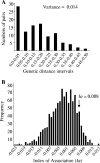Genotyping of Candida orthopsilosis clinical isolates by amplification fragment length polymorphism reveals genetic diversity among independent isolates and strain maintenance within patients
- PMID: 17329454
- PMCID: PMC1865889
- DOI: 10.1128/JCM.00243-07
Genotyping of Candida orthopsilosis clinical isolates by amplification fragment length polymorphism reveals genetic diversity among independent isolates and strain maintenance within patients
Abstract
Candida parapsilosis former groups II and III have recently been established as independent species named C. orthopsilosis and C. metapsilosis, respectively. In this report, 400 isolates (290 patients) previously classified as C. parapsilosis by conventional laboratory tests were screened by BanI digestion profile analysis of the secondary alcohol dehydrogenase gene fragment and by amplification fragment length polymorphism (AFLP). Thirty-three strains collected from 13 patients were identified as C. orthopsilosis, thus giving the first retrospective evidence that C. orthopsilosis was responsible for 4.5% of the infections/colonization attributed to C. parapsilosis. AFLP was proven to unambiguously identify C. orthopsilosis at the species level and efficiently delineate intraspecific genetic relatedness. A high percentage of polymorphic AFLP bands was observed for independent isolates collected from each patient. Statistical analysis of the pairwise genetic distances and bootstrapping revealed that clonal reproduction and recombination both contribute to C. orthopsilosis genetic population structure. AFLP patterns of sequential isolates obtained from two patients demonstrated that a successful strain colonization within the same patient occurred, as revealed by strain maintenance in various body sites. No association between AFLP markers and drug resistance was observed, and none of the clinical C. orthopsilosis isolates were found to produce biofilm in vitro.
Figures




References
-
- Almirante, B., D. Rodríguez, M. Cuenca-Estrella, M. Almela, F. Sanchez, J. Ayats, C. Alonso-Tarres, J. L. Rodriguez-Tudela, A. Pahissa, and the Barcelona Candidemia Project Study Group. 2006. Epidemiology, risk factors, and prognosis of Candida parapsilosis bloodstream infections: case-control population-based surveillance study of patients in Barcelona, Spain, from 2002 to 2003. J. Clin. Microbiol. 44:1681-1685. - PMC - PubMed
-
- Ball, L. M., M. A. Bes, B. Theelen, T. Boekhout, R. M. Egeler, and E. J. Kuijper. 2004. Significance of amplified fragment length polymorphism in identification and epidemiological examination of Candida species colonization in children undergoing allogeneic stem cell transplantation. J. Clin. Microbiol. 2004. 42:1673-1679. - PMC - PubMed
-
- Bonassoli, L. A., M. Bertoli, and T. I. E. Svidzinski. 2005. High frequency of Candida parapsilosis on the hands of healthy hosts. J. Hosp. Infect. 59:159-162. - PubMed
Publication types
MeSH terms
Substances
LinkOut - more resources
Full Text Sources
Medical

